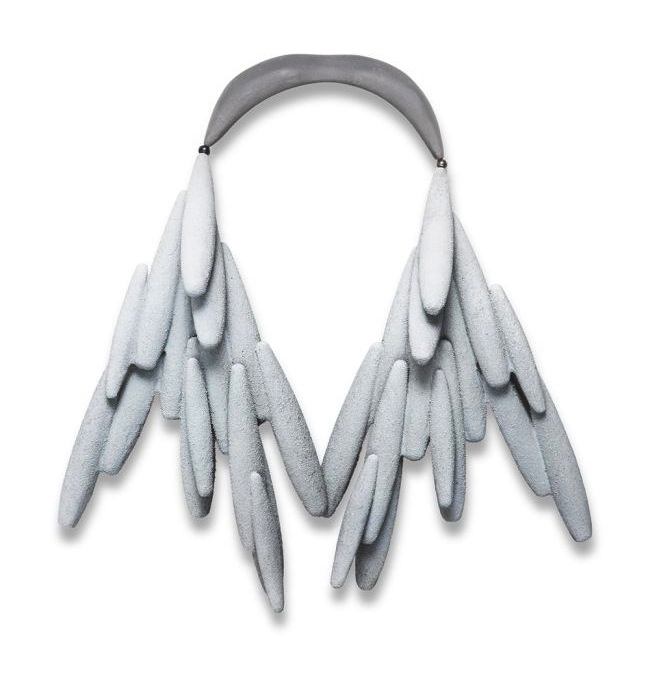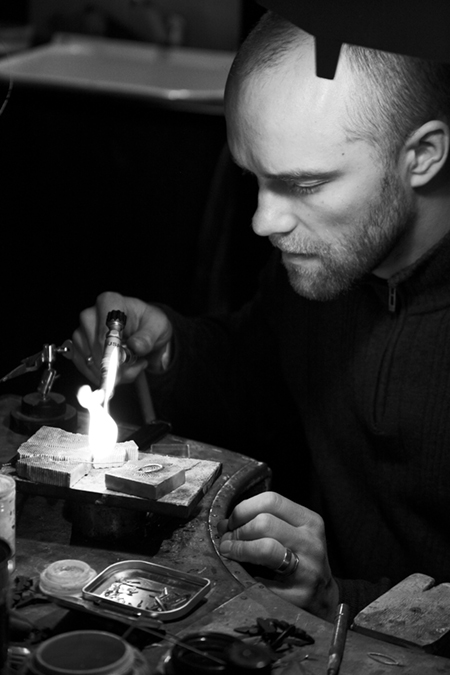
Tanel Veenre. The Choreography of Jewelery
Meeting-Up With Estonian Contemporary Jewelery Designer Tanel Veenre
18/11/2014
Like from hidden underwater depths, from the deepest of rain forests, from places where no one has ever been before, from the phantasmagorical planet Pandora – that is what the natural shapes and colors created by Tanel Veenre are like. Kind of nature-made, kind of human-made... can anybody really differentiate and contrast the two?
Even though he could have become a musician (like several generations of his family have before him), the Estonian contemporary jewelery designer Tanel Veenre (1977) sensed that his hands had an ability, the ability to allow the most diverse natural-like shapes – playful, poetic and dramatic compositions – to sprout, bud and blossom. Just like from fertile soil, his fingers give rise to art that transforms into nature. Human nature. This happens easily, for in nature, grass does not struggle to grow – it simply grows. Fish don't struggle to swim, they simply swim. Flowers don't struggle to bloom, they simply bloom. Perhaps that is why, when asked if he tries to put contemporary messages or socially extant issues into his works, he replies that, in a process that happens so naturally and intuitively, it is difficult to integrate something consciously. That is why he makes his appeals to society's consciousness through the written and spoken word. “I challenge people to dream only by consequence. Not in an escapist way. I invite them to break the framework through dreaming...”
Tanel Veenre. Fruits of paradise. Publicity photo
Tanel Veenre graduated from the Estonian Academy of Art under the tutelage of Kadri Mälk – the head of the Academy's Metal Design Department, as well as Estonia's most well-known jewelery artist. Veenre also spent a year in an exchange program at the Gerrit Rietveld Academie in Amsterdam. His works can be found in the Estonian Museum of Applied Art and Design and in the Estonian History Museum, as well as in the public collections of France's Espace Solidor and California's Rotasa Collection Trust. Since 2005, Veenre has been teaching in the Metal Art Department of the Estonian Academy of Art, and since 2012 he has been working as a professor in the Academy's Department of Design. Alongside his academic work in Estonia, Veenre has also led creative workshops in Israel, Mexico, Chile, Finland and Sweden.
Tanel Veenre. Publicity photo
Beginning with 2005, Veenre has had solo shows in Estonia, Lithuania, Germany, France, Belgium, the Netherlands, Sweden, the USA, Madeira Island, Turkey and Mexico. He has recently begun working with a gallery in Bangkok, and in January will be traveling to Thailand. An interesting incident brought him into contact with 80-year-old gallerist Thomas Cohn, who in Brazil represents such big-name contemporary artists as Tony Cragg. Cohn recently opened a contemporary jewelery gallery in São Paulo, and is currently scoping out the countries of Northern Europe. Veenre is happy about this new spurt of development in the contemporary jewelery market, but admits that: “When I create something, I'm not thinking about the market and how my work will fit into it. At the same time, I wish to free myself of the things that I create. I'm not sentimental, and I don't want to keep them for myself – they'd pile up, and that could kill the ability to create something new. I need space to breathe.”
This has been an intensive year – Veenre's works have been widely shown, from Istanbul's SODA gallery to Pont&Plas in Ghent; from Amsterdam's RA to Stockholm's Platina; from the dream world of metaphysics at the gallery Putti in Riga to the Trofejas gallery in Berlin.
Alongside his extravagant, large-scale objects at gallery Putti, Veenre has also displayed his fashion accessory line – something he started two years ago. The line is largely made up of silver pieces that feature amethyst, a favorite of Veenre. He explains that this jewelery is simple to wear, easy to sell, and that by creating them, he can get closer to the majority of people. Veenre likes to use the following metaphor: “Art is like a syrup that is so concentrated that there are only a few that are able to drink it. Only one out of a million has the courage to taste this poison.” So, to make this essence drinkable, he dilutes it with a good dose of water, thereby making his artworks as approachable and wearable as he can.
Tanel Veenre. Brooch Animus Gothic. Photo: Tanel Veenre
When viewing the exhibited “Pallindrome” (2013/14) collection, it seems that Veenre's daring began with his choice of base material from which to make this sizable collection. The necklaces and brooches have been crafted from dried seahorses – creatures that once lived among coral reefs, seaweed and mangrove forests. He sources the seahorses from medicine shops in China; in traditional Chinese, Japanese and other Asian cultures, ground seahorses are believed to be aphrodisiacal in nature. Seahorses can change their gender, and it is the males who give birth to their offspring. This biological curiosity, however, is not at the core of Veenre's story – these marine animals attract him with their mythological image: “Many people don't even believe that these creatures truly exist, and associate them only with made-up fairy tales. Much like they do with sphinxes or centaurs... That's why I choose to think about the mythological aspect that these tiny creatures carry with them.”
Veenre admits that he has something of he dramatic stage director within him, and he himself came up with the idea behind the layout of the exhibition at the Putti gallery – several foam rubber mattresses hang from the ceiling, serving as background for his works. “These are the stage decorations I came up with for my ballet production (…) I see the seahorses as ballet dancers upon the stage, and I am the choreographer. In this way, I arrange and rearrange them in various combinations – symmetrical, asymmetrical...”
Using them just like pieces from a construction set, he creates various shapes – images of animals, baroque forms, or lighter, rococo-style shapes. Then he covers them in layers of resin, in various thicknesses and colors.

Tanel Veenre. Neckless from My Kingdom collection. Publicity photo
The “My Kingdom” (2011/12) series is made up of large-scale, yet extremely lightweight compositions. Their hypnotically-colored surfaces conceal a very simple secret – the jewelery is made from wooden fishing floats. “Everything starts with the material. When I begin, I never know what the final result will be. I have a plan in mind, but usually that gets turned upside down during the working process. I'm very open, open to a dialog with the material. Materials are smart – they simply start telling you how to combine them, link them... Just like plants, the works grow from my hands. With complete ease, and organically. And that's how I experience it – I just sow the seeds and they grow by themselves.”
Tanel Veenre. Neckless Eden from My Kingdom collection. Publicity photo
One would assume that an artist with this sort of approach to his creative work has a close relationship to nature, but quite the opposite is true – Veenre claims that he spends little time in the natural environment. He simply loves it from afar. “Maybe I should finally change this. I work a lot, and I tend to run away from it all – this includes nature and friends... While in Chile, I had the chance to spend time in the mountains... That was definitely the highlight of the year!” Accordingly, Veenre likes to quote Bob Dylan: “I am against nature. I don't dig nature at all. I think nature is very unnatural. I think the truly natural things are dreams, which nature can't touch with decay...”
Tanel Veenre. Brooch from My Kingdom collection. Publicity photo
Veenre is currently working on his second book. The first one, “EHE / JEWEL”, came out five years ago. When asked about how his work has changed over his creative career, he answers that, at the moment, he has been thinking and analyzing this question a lot: “On one hand, it seems as if nothing much has changed. Fundamentally, I think I'm very stable. In terms of my fascination with the mythological – the dreamy, mystical-nature side, that's always been there. The only thing that has changed are the means with which to express it. Earlier, the materials that I used were simpler – mostly wood.”

Tanel Veenre in jewelery creation process. Publicity photo